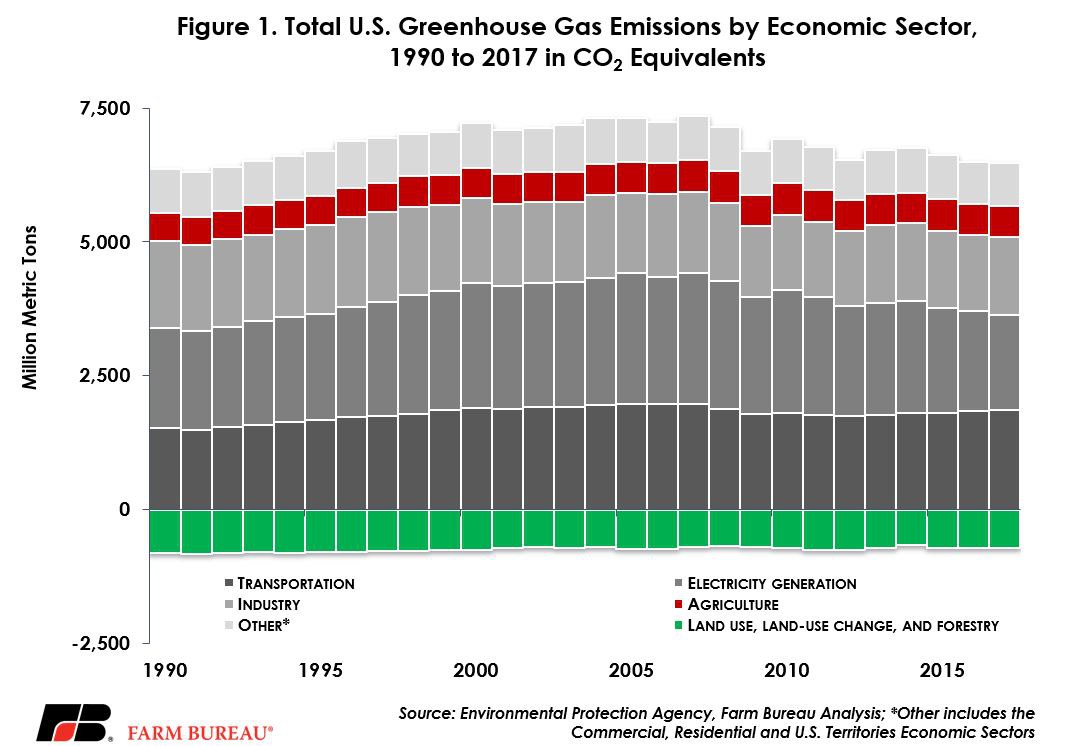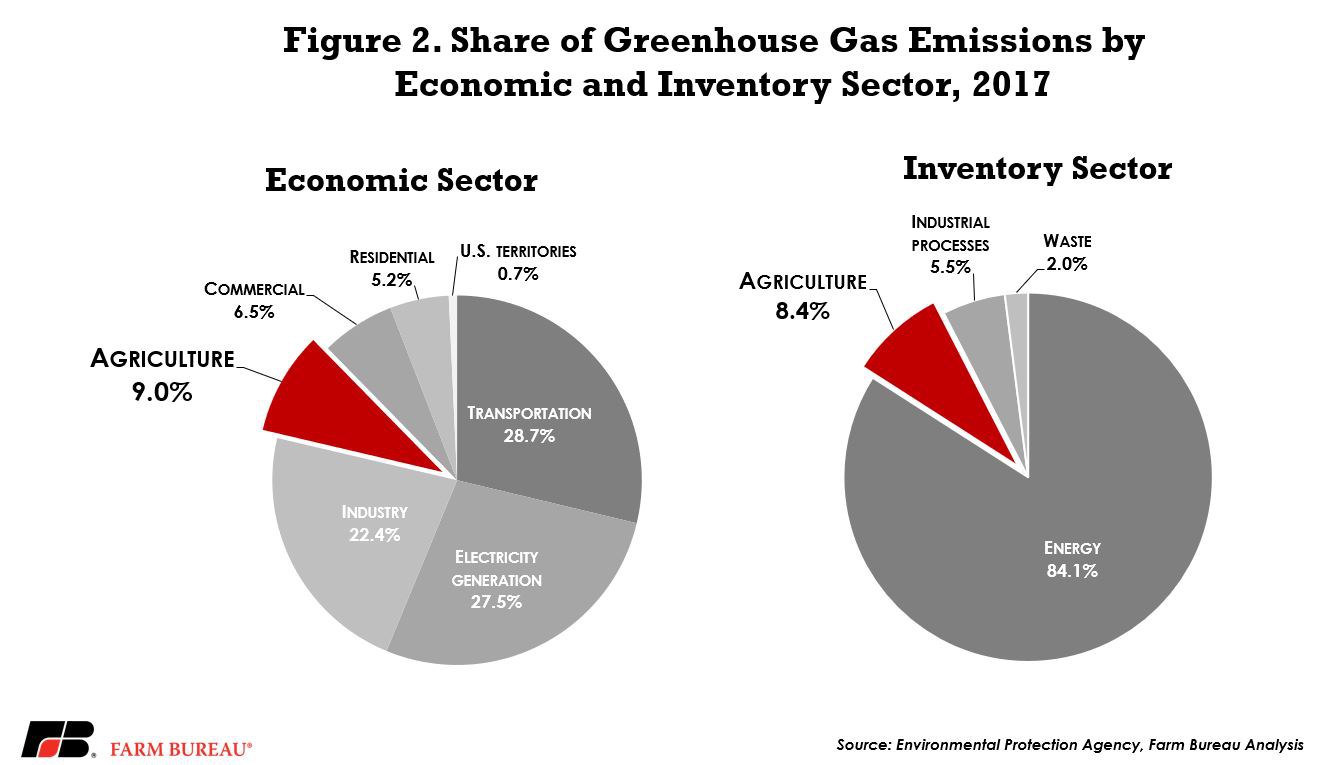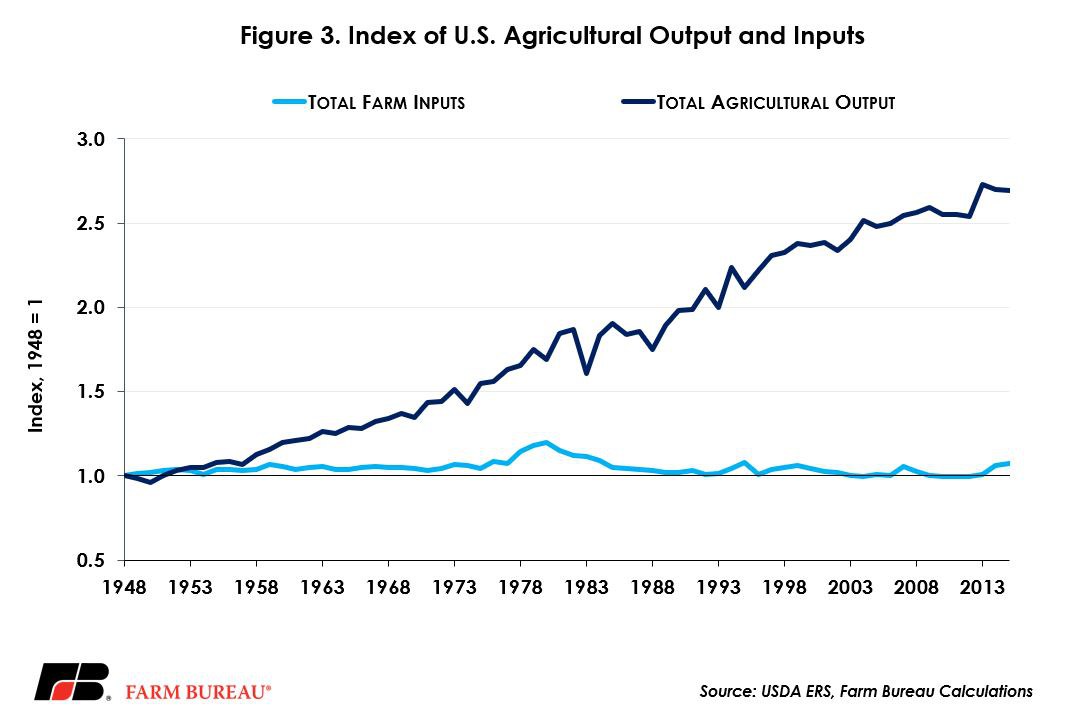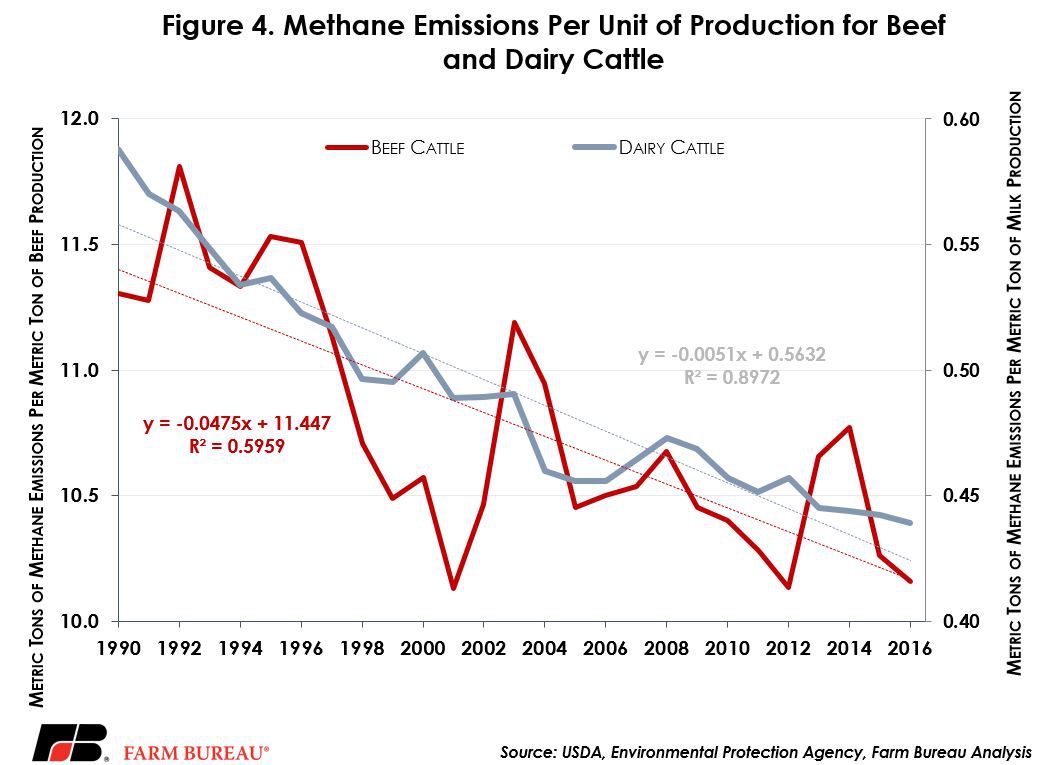Agriculture and Greenhouse Gas Emissions
TOPICS
Sustainability
photo credit: AFBF Photo, Philip Gerlach
Over many years, as the international community has sought to learn more about carbon emissions, their sources and impact, agriculture has been part of the conversation — not only in regard to its emissions but in its potential to serve as a “carbon sink.” Recent policy discussions on Capitol Hill have renewed interest in this topic.
Today’s Market Intel uses data from USDA’s Economic Research Service and the Environmental Protection Agency’s Greenhouse Gas Inventory Data Explorer to provide clarity on agriculture’s contribution to greenhouse gas emissions and demonstrate how productivity trends and technology adoption are reducing the footprint of agricultural greenhouse gas emissions and increasing sustainability.
Greenhouse Gas Emissions by Economic Sector
In February 2019 EPA released the annual Draft Inventory of U.S. Greenhouse Gas Emissions and Sinks report, revealing total greenhouse gas emissions in 2017 at 6.5 billion metric tons in carbon dioxide equivalents, down 0.3 percent from 2016 levels and the lowest level in 25 years. When including land use, land-use changes and forestry, net greenhouse gas emissions totaled 5.8 billion metric tons in carbon dioxide equivalents. The decline in greenhouse gas emissions was due to lower fossil fuel combustion, an ongoing shift from coal to natural gas and increased use of renewable fuels. Figure 1 highlights the trends in greenhouse gas emissions by economic sector.

The largest economic sector in greenhouse gas emissions was the transportation sector, representing 29 percent of all emissions. Emissions from the transportation sector totaled 1.86 billion metric tons, up 0.5 percent from 2016 and the highest level in nine years. Following transportation was the energy sector, i.e., electric power, representing 28 percent of all emissions and totaling 1.8 billion metric tons. Electric power emissions were down 4.2 percent from 2016 and the lowest level since the data was first recorded in 1990.
Emissions from the industry sector represented 22 percent of all emissions and totaled 1.5 billion metric tons, up 2.7 percent above prior-year levels. Overall, emissions from the industry sector have declined in recent decades, down 11 percent since 1990, due to the shift in the U.S. economy from a manufacturing-based economy to a service-based economy. Other greenhouse gas emission sources, including commercial, residential and U.S. territories, totaled 798 million metric tons in 2017 and represented 12 percent of all emissions. These emissions were up slightly from 2017 due to higher greenhouse gas emissions from residential use.
Agricultural Greenhouse Gas Emissions
Greenhouse gas emissions related to agriculture totaled 582 million metric tons in 2017, up slightly from prior-year levels, but down 2 percent from a decade ago. However, farmers and ranchers also contribute to carbon sequestration efforts, i.e., greenhouse gas removal, in the form of the management and preservation of grasslands, wetlands and forestry. During 2017, forest land management and land converted to forestry contributed to a 741-million-metric-ton reduction in greenhouse gas emissions, while wetland preservation reduced emissions by 4 million metric tons. When including total emissions and removals, total land use, land-use change and forestry represented a net emission reduction of 713 million metric tons.
In 2017, agriculture represented 9 percent of all emissions when measured by economic sector. When measured using the United Nations Framework Convention on Climate Change, an international standard, agriculture’s contribution to greenhouse gas emissions totaled 8.4 percent. Figure 2 highlights agriculture’s contribution to greenhouse gas emissions for 2017.

Improvements in Agricultural Productivity
While agriculture’s contribution to greenhouse gas emissions climbed in 2017, it is also very important to recognize that agricultural production across many sectors was at or near record-highs in 2017. Driven by substantial improvements in crop yields, U.S. farmers and ranchers produced 14.6 billion bushels of corn in 2017, nearly double the volume produced in 1990. In 2017, soybean production totaled 4.4 billion bushels and was 132 percent higher than 1990’s production volume. In fact, due to improvements in crop yields, while crop production continues to meet or exceed previous records, total cropland in production declined by 55 million acres from 1997 to 2012. The decline in cropland is one of the reasons the U.S. has been able to achieve afforestation in some regions.
Overall, technological developments in agricultural production, including crop and animal genetics, chemicals and equipment, have improved agricultural output without adding significantly to inputs. Productivity in agriculture was 270 percent greater in 2017 than in 1948, and 136 percent greater than 1990, while total farm inputs were mostly unchanged from 1948, and only marginally higher than in 1990, according to USDA’s Economic Research Service, Figure 3.

Agriculture is Becoming More Sustainable
There are two primary sources of agricultural-related greenhouse gas emissions: crop cultivation and livestock production. Since 1990, crop cultivation has represented 50 percent of agriculture-related greenhouse gas emissions while livestock production has represented approximately 42 percent of agriculture-related greenhouse gas emissions. Of livestock-related emissions, in recent years approximately two-thirds of emissions have been related to methane emissions from enteric fermentation.
As a percent of total U.S. greenhouse gas emissions, methane emissions represent approximately 10 percent of all emissions and are dwarfed by carbon dioxide, which represents more than 80 percent of all greenhouse gas emissions. Methane does have a larger impact on global warming potential than carbon dioxide, but the half-life in the atmosphere is also significantly lower.
Methane emissions from ruminant animals, principally cattle and sheep, represent only a quarter of all methane emissions and gross livestock emissions have a very small footprint, representing approximately 3.5 percent of greenhouse gas emissions since 1990. Furthermore, methane from livestock can be turned into an energy source through methane digesters – avoiding the emissions into the atmosphere and producing a renewable energy source.
While emissions from crop and livestock production have remained relatively flat since 1990, once the productivity gains are counted, agriculture has been on a long path to sustainability. As an example, from 1990 to 2016, total methane emissions per unit of beef and milk production declined by 10 percent and 25 percent, respectively.
A linear regression of methane emissions per unit of beef and milk production reveals a statistically significant trend that demonstrates how the productivity improvements in livestock production are contributing to a lower greenhouse gas intensity footprint, Figure 4.

Summary
Focusing only on aggregate greenhouse gas emission levels can obscure the successful achievements agriculture has made in the areas of productivity and sustainability. These need to be considered in any policy debates surrounding efforts to reduce carbon emissions.
U.S. farmers and ranchers are producing more crops, livestock, fruits and vegetables, fuel and fiber than ever before while using less water, protecting against erosion and conserving more soil, avoiding nutrient loss, increasing wildlife habitat and improving biodiversity while using less cropland.
Farmers also contribute to reductions in greenhouse gas emissions by sequestering carbon in that soil. In addition to sequestration, livestock producers have greatly enhanced their sustainability efforts by investing in methane digestor technology – reducing methane emissions into the atmosphere and producing renewable energy.
Special thanks to Allison Thomson, Science & Research Director, Field to Market for thoughtful contributions and edits to this analysis.
